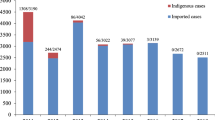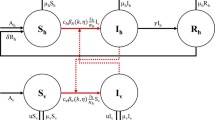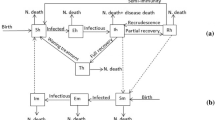Abstract
Malaria is a life-threatening mosquito-borne disease. It is transmitted through the bite of an infected Anopheles mosquito. Malaria may be fatal if not treated promptly. Malaria is a major public health problem in India. Here we propose an SIRS model to study the transmission dynamics of malaria with saturated treatment. We assume that the mosquito population is growing logistically in the environment. Here we include a saturated type treatment function which is more suitable for the regions with limited resources. We discuss the existence and stability of different equilibria of the proposed model. We also compute the basic reproduction number \(R_0\) which plays an important role in existence and stability of equilibria of the model. For \(R_0 < 1\), backward bifurcation occurs, which suggests that lowering \(R_0\) below one is not enough to eliminate the disease from the population. We estimate the key parameter corresponding to transmission of malaria using real data from different states of India by least square method. We also perform sensitivity analysis using PRCC to identify the key parameters which influence the infection prevalence of the disease and the basic reproduction number. Numerical simulations are presented to illustrate the analytic findings. Our numerical results suggest that infected population should get proper treatment and increase in the death rate of mosquito can also help to eradicate the malaria disease from the population.










Similar content being viewed by others
References
WHO.: Facts about malaria (2019), https://www.who.int/news-room/facts-in-pictures/detail/malaria
National Vector Borne Disease Control Programme.: (2003), https://nvbdcp.gov.in/index1.php?lang=1&level=1&sublinkid=5784&lid=3689
Malaria Site.: Malaria in India (2019), https://www.malariasite.com/malaria-india/
Beretta, E., Capasso, V., Garao, D.G.: A mathematical model for malaria transmission with asymptomatic carriers and two age groups in the human population. Math. Biosci. 303, 155–156 (2018)
Wang, L., Teng, Z., Ji, C., Feng, X., Wang, K.: Dynamical behaviors of a stochastic malaria model: a case study for Yunnan. China. Phys. Stat. Mech. Appl. 521, 435–454 (2019). https://doi.org/10.1016/j.physa.2018.12.030
Agusto, F.B., Valle, S.Y.D., Blayneh, K.W., Ngonghala, C.N., Goncalves, M.J., Li, N., Zhao, R., Gong, H.: The impact of bed-net use on malaria prevalence. J. Theor. Biol. 320, 58–65 (2013)
Chitnis, N., Cushing, J.M., Hyman, J.M.: Bifurcation analysis of a mathematical model for malaria transmission. SIAM J. Appl. Math. 67, 24–25 (2006)
Gratz, N.: Emergency control of Aedes aegypti as a disease vector in urban areas. J. Am. Mosq. Control Assoc. 7(3), 353–365 (1991)
Ghosh, M.: The spread of malaria with human reservoir: effect of environmental discharges. J. Adv. Res. Dyn. Control Syst. 6(3), 79–100 (2014)
Orwa, T.O., Mbogo, R.W., Luboobi, L.S.: Mathematical model for the in-host malaria dynamics subject to malaria vaccines. Lett. Biomath. 5(1), 222–251 (2018). https://doi.org/10.1080/23737867.2018.1526132
Mandal, S., Sarkar, R.R., Sinha, S.: Mathematical models of malaria: a review. Malaria J 10, 1–19 (2011)
Chiyaka, C., Tchuenche, J.M., Garira, W., Dube, S.: A mathematical analysis of the effects of control strategies on the transmission dynamics of malaria. Appl. Math. Comput. 195(3), 641–662 (2008)
Mwanga, G., Haario, H., Capasso, V.: Optimal control problems of epidemic systems with parameter uncertainties: application to a malaria two-age-classes transmission model with asymptomatic carriers. Math. Biosci. 261, 1–12 (2015)
Agusto, F.B., Marcus, N., Okosun, K.O.: Application of optimal control to the epidemiology of malaria. Electr. J. Differ. Equ. 2012(81), 1–22 (2012)
Athitan, S., Ghosh, M.: Stability analysis and optimal control of a malaria model with larvivorous fish as biological control agent. Appl. Math. Inf. Sci. 9(4), 1893–1913 (2015)
Cai, L., Li, X.Z., Tuncer, N., Martcheva, M., Lashari, A.A.: Optimal control of a malaria model with asymptomatic class and superinfection. Math. Biosci. 288, 94–108 (2017)
Cai, L., Tuncer, N., Martcheva, M.: How does within-host dynamics affect population-level dynamics? Insights from an immuno-epidemiological model of malaria. Math. Methods Appl. Sci. 40(18), 6424–6450 (2017)
Bhatt, S., Weiss, D., Cameron, E., Bisanzio, D., Mappin, B., Dalrymple, U., Wenger, E.A.: The effect of malaria control on Plasmodium falciparum in Africa between 2000 and 2015. Nature 526(7572), 207 (2015)
Cai, L., Huang, J., Song, X., Zhang, Y.: Bifurcation analysis of a mosquito population model for proportional releasing sterile mosquitoes. Discr. Contin. Dyn. Syst. Seri. B 24, 6279–6295 (2019)
Cai, L., Li, Z., Liu, J.: Modeling and analyzing dynamics of malaria transmission with host immunity. Int. J. Biomath. 12(6), 1950074 (2019)
Cai, L., Ai, S., Fan, G.: Dynamics of delayed mosquitoes populations models with two different strategies of releasing sterile mosquitoes. Math. Biosci. Eng. 15(5), 1181–1202 (2018). https://doi.org/10.3934/mbe.2018054
Feng, W.J., Cai, L., Liu, K.: Dynamics of a dengue epidemic model with class-age structure. Int. J. Biomath. 10(08), 1750109 (2017)
Dubey, B., Patra, A., Srivastava, P.K., Dubey, U.S.: Modeling and analysis of an SEIR model with different types of nonlinear treatment rates. J. Biol. Syst. (2013). https://doi.org/10.1142/S021833901350023X
Zhang, X., Liu, X.: Backward bifurcation of an epidemic model with saturated treatment function. J. Math. Anal. Appl. 348(1), 433–443 (2008)
Li, X.-Z., Li, W.S., Ghosh, M.: Stability and bifurcation of an SIS epidemic model with treatment. Chaos Solit. Fract. 42(5), 2822–2832 (2009)
Gao, L.Q., Hethcote, H.W.: Disease transmission models with density dependent demographics. J. Math. Biol. 32, 717–731 (1992)
Driessche, P.V., Watmough, J.: Reproduction numbers and subthreshold endemic equilibria for compartmental models of disease transmission. Math. Biosci. 180, 29–48 (2002)
Bakary, T., Boureima, S., Sado, T.: A mathematical model of malaria transmission in a periodic environment. J. Biol. Dyn. 12(1), 400–432 (2018). https://doi.org/10.1080/17513758.2018.1468935
Mukhtar, A.Y.A., Munyakazi, J.B., Ouifki, R.: Assessing the role of climate factors on malaria transmission dynamics in South Sudan. Math. Biosci. 310, 13–23 (2019)
Castillo-Chavez, C., Song, B.: Dynamical model of tuberculosis and their applications. Math. Biosci. Eng. 1, 361–404 (2004)
National Health Portal of India, https://www.nhp.gov.in/world-malaria-day-2018, Visited on Jan 10, 2019
Blower, S.M., Dowlatabadi, H.: Sensitivity and uncertainty analysis of complex models of disease transmission: an HIV model, as an example. Int. Stat. Rev. 62, 229–243 (1994)
Marino, S., Hogue, I.B., Ray, C.J., Kirschner, D.E.: A methodology for performing global uncertainty and sensitivity analysis in systems biology. J. Theor. Biol. 254, 178–196 (2008)
Ngonghala, C.N., Del Valle, S.Y., Zhao, R., Mohammed-Awel, J.: Quantifying the impact of decay in bednets efficacy on malaria transmission. J. Theor. Biol. 364, 247–261 (2014)
Ngonghala, C.N., Mohammed, J., Zhao, R., Prosper, O.: Interplay between insecticide-treated bednets and mosquito demography: implications for malaria control. J. Theor. Biol. 397, 179–192 (2016)
Acknowledgements
The authors thank the handling editor and anonymous referees for their valuable comments and suggestions that led to an improvement of our original manuscript. This research was supported by the research grants of DST, Govt. of India, via a sponsored research project: FILE NO. EMR/2017/003139.
Author information
Authors and Affiliations
Corresponding author
Additional information
Publisher's Note
Springer Nature remains neutral with regard to jurisdictional claims in published maps and institutional affiliations.
Rights and permissions
About this article
Cite this article
Srivastav, A.K., Ghosh, M. Modeling the transmission dynamics of malaria with saturated treatment: a case study of India. J. Appl. Math. Comput. 67, 519–540 (2021). https://doi.org/10.1007/s12190-020-01469-7
Received:
Revised:
Accepted:
Published:
Issue Date:
DOI: https://doi.org/10.1007/s12190-020-01469-7
Keywords
- Malaria
- Logistic growth
- Bifurcation analysis
- Sensitivity analysis
- Parameter estimation
- Numerical simulation




